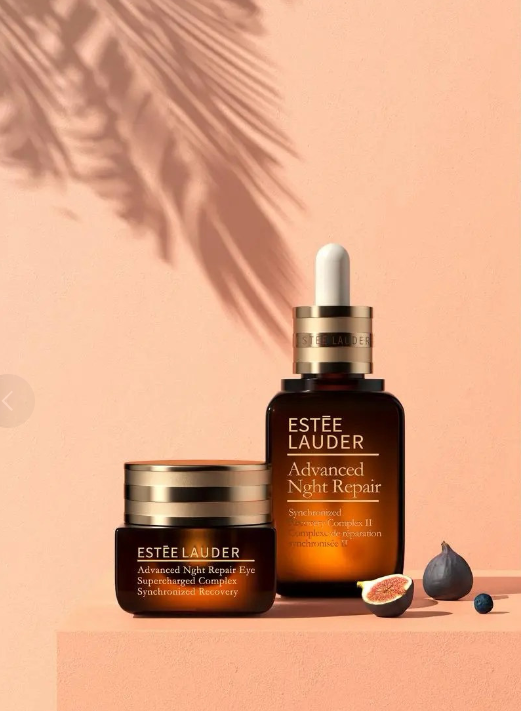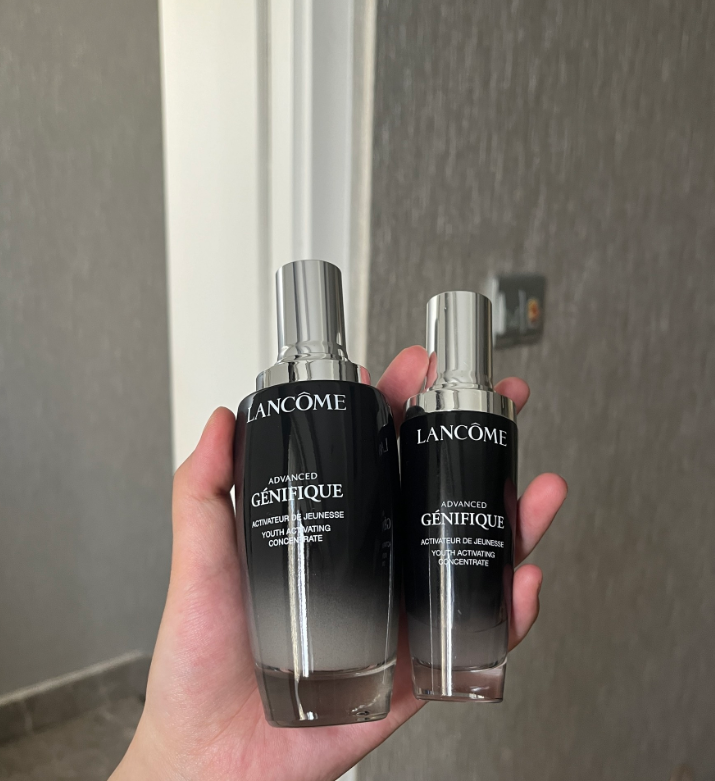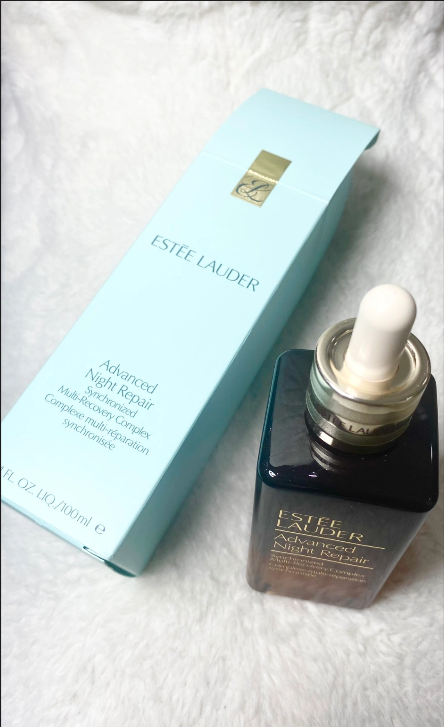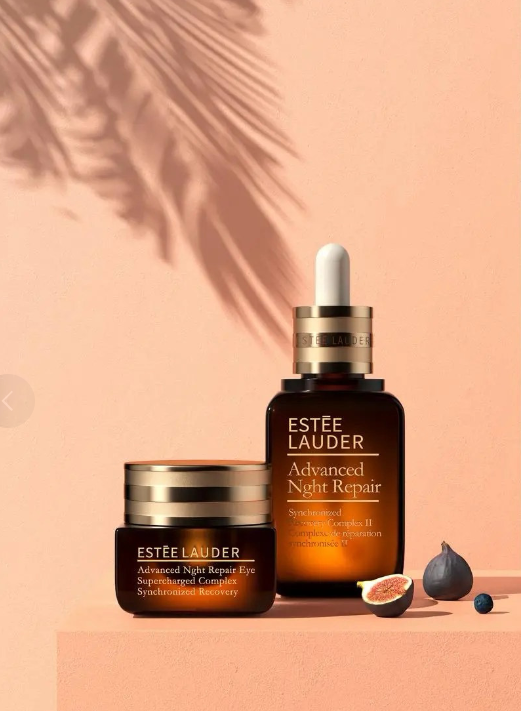
The ultimate competition between Lancome's Little Black Bottle and Estee Lauder's Little Brown Bottle

The ultimate PK between Lancome's Little Black Bottle and Estee Lauder's Little Brown Bottle
Little Black Bottle: Glycerin, Sodium Hyaluronate
Little Brown Bottle: Methyl Gluceth-20, Butylene Glycol, 1,3-Propanediol, Glycereth-26
The moisturizing ingredients of Little Black Bottle are only glycerin and hyaluronic acid (in fact, the role of hyaluronic acid here is closer to a thickener, and it is placed here mainly to take care of the public's cognition). Although they are all natural ingredients in the skin and have a higher affinity to the skin, they are matched in a single way and are too hydrophilic, so the wetting power for the stratum corneum is poor; while Little Brown Bottle is just the opposite.
PS: Affinity is not what I usually call "skin-friendly". Affinity refers to the biocompatibility of the ingredients. The intuitive advantage is that it is not easy to cause skin irritation and allergies. Similar moisturizers include panthenol, β-glucan, etc.; skin-friendly refers to the wetting power of the stratum corneum. The advantage of strong wetting power is that it is easier to penetrate deep into the stratum corneum and improve the water loss of the deep stratum corneum better (but the corresponding irritation is also greater). However, strong moisturizing power is more meaningful for young and mature skin over 25 years old, and even for dehydrated skin. It doesn’t matter for young skin, because your deep stratum corneum is not dehydrated, and this effect is only significant in a single water phase system, and there is not much difference in a water-oil two-phase system (both the black bottle and the brown bottle are water-oil two-phase). For a deeper explanation of the reasons, see here: What kind of product is reliable for removing eye wrinkles?

Summary: The black bottle pursues a lighter skin feel, while the brown bottle focuses on the "hydrating" effect (the stickiness is also inevitable).
[Oil Comparison]
Black Bottle: Dimethicone, Octyldodecanol
Brown Bottle: Squalane, Ethylhexyl Methoxycinnamate, Tocopherol Acetate, Hydrogenated Lecithin, Lecithin
The structural characteristics of the oils used in the Black Bottle are far different from the skin's own lipids, and the affinity for the skin is relatively poor. Among them, dimethicone is very inert and basically will not be absorbed by the skin. The small molecular weight will evaporate, and the large molecular weight will form a film. Octyldodecanol has a certain penetration-promoting effect, but the overall formula is more inclined to form a light and smooth film on the skin surface. This film can be considered to have a certain protective effect on the skin (mainly relying on the physical effect of skin lubrication), and can also help the absorption of active ingredients to a certain extent, but the moisturizing and sealing performance can be ignored; the oils used in the Brown Bottle are generally closer to the lipids naturally secreted by the skin itself, and have a stronger affinity with the skin. The main purpose is to penetrate into the stratum corneum and, together with the hydrophilic moisturizer, build a fuller and tenderer stratum corneum.
Summary: The Little Black Bottle focuses on creating a smooth skin feel, while the Little Brown Bottle focuses on moisturizing and softening (continues to be sticky).
[Emulsifier Comparison]
Little Black Bottle: PEG-20 Methyl Glucose Sesquistearate, PEG-60 Hydrogenated Castor Oil
Little Brown Bottle: Oleth-3 Phosphate, Oleth-3, Oleth-5, Choleth-24, Ceteth-24
The most noteworthy thing in this part is Oleth-3 Phosphate, Oleth-3, Oleth-5 in the Little Brown Bottle: These three together are actually a compounded microemulsifier of a British imported raw material company HeX. It is considered a signature product of the company. It has a relatively moisturizing and docile skin feel, and a special unpleasant smell (all covered by the white chamomile flower oil at the back). Estee Lauder's Little Brown Bottle has been updated many times so far, and many things in it have been changed, but this emulsification system has not changed. You can imagine its importance to the Little Brown Bottle. The PEG-20 methyl glucose sesquistearate and PEG-60 hydrogenated castor oil in Lancome are both more traditional water-soluble non-ionic emulsifiers. The former is responsible for blending the oil and water in the little black bottle, and the latter is mainly responsible for solubilizing the essence. Compared with the three soul emulsifiers in the little brown bottle, both of them are refreshing and moisturizing. Okay, okay, refreshing and moisturizing again. . .
Summary: The little black bottle continues to take the route of refreshing and moisturizing, while the little brown bottle continues its moisturizing and softening.

[Thickener comparison]
Little black bottle: ammonium polyacryloyldimethyl taurate, sodium hyaluronate, xanthan gum
Little brown bottle: carbomer, xanthan gum, sodium hyaluronate
The most noteworthy thing in this regard is the ammonium polyacryloyldimethyl taurate in the little black bottle, which is another thickening emulsifier from a well-known raw material company Coxen. It is said that the brand provided to L'Oreal is a special brand, which other companies cannot get (but there are similar things to choose from). L'Oreal also likes to use it, and almost all of its mid-to-high-end brands are using it. According to official information and the actual situation of this formula, the existence of this thing can provide the formula with a nested space structure to encapsulate silicone oil and octyl dodecanol, improve the stability of the product emulsification system, and more importantly, the finished product has a light texture and moisturizing skin.
Summary: The little black bottle has been running wild on the road of refreshing, while the little brown bottle still only cares about its own moisturizing business, but the overall impact in this regard is not much different.
[Comparison of preservative systems]
Little black bottle: phenoxyethanol, caprylyl glycol, sodium benzoate
Little brown bottle: phenoxyethanol, caprylyl glycol, ethylhexylglycerin, hexylene glycol
There is actually nothing to say about the preservative system of these two. They are very similar. If you must find some differences, it is the ethylhexylglycerin and hexylene glycol compounded in the little brown bottle. In addition to the role of preservatives and synergists, these two things also have certain moisturizing functions.
Summary: OK, the little brown bottle has already armed the antiseptic system with the appeal of moisturizing and softening. . .
[Skin feel regulator comparison]
Little black bottle: denatured ethanol
Little brown bottle: polyethylene glycol-75, bis-PEG-18 methyl ether dimethyl silane
Needless to say about the little black bottle, denatured ethanol is used to increase the refreshing feeling; and the little brown bottle is just the opposite rhythm, because polyethylene glycol-75 and bis-PEG-18 methyl ether dimethyl silane are both heavy existences that can enhance the moisturizing feeling. In fact, it is not a bad idea to put them in the hydrophilic moisturizer. The main purpose of putting them here is to take care of the denatured ethanol that has nowhere to go. . .
Little Black Bottle: Bifida Ferment Lysate, Hydroxyethylpiperazine Ethane Sulfonic Acid, Ascorbyl Glucoside, Adenosine, Yeast Extract, Salicyloyl Phytosphingosine
Little Brown Bottle: Sudan Cola Nut (COLA ACUMINATA) Seed Extract, Caffeine, Yeast Extract, Pantethine, Bisabolol, Bifida Ferment Lysate, Sodium Hyaluronate, Hydrogenated Lecithin, Anthemis Nobilis Flower Oil, Echinacea Purpurea Extract, Tocopheryl Acetate, Sodium RNA, Hydrolyzed Algin, Lecithin, Lactobacillus Ferment
In this regard, the Little Black Bottle gives people the feeling that the whole bottle is written with the word "exfoliation". If you don't believe it, let's analyze it one by one.
Bifidobacterium fermentation product lysate: a very complex mixture, the specific composition is not completely clear, but according to the current information, it can be basically considered that this thing has a similar exfoliating effect to fruit acid, or has the so-called effect of promoting skin metabolism, skin rejuvenation and whitening, and fine pores. It is indeed similar to pitera in the magic water. For specific analysis, please refer to the analysis of the magic water: Is it too early to start using SKII magic water at the age of 20?
Look at its ranking again, there is no doubt that it is the main ingredient of the little black bottle! Just from the formula table at first glance, Lancome is also quite competitive. In addition to water, the second is it. In fact, Lancome can also promote that it is full of yeast essence~~~
In fact, in addition to this type of fermented extract, there is a large category of ingredients in the cosmetic raw material industry that are dressed in the guise of plant extracts to stimulate skin rejuvenation, exfoliation and regeneration. This has even changed my inherent concept that the efficacy of traditional daily chemical products must not be strong. . . . I will push it on my official account in the near future, welcome to follow.
Hydroxyethylpiperazineethanesulfonic acid: There is nothing much to say about this. It was once the exclusive exfoliant of the L'Oreal Group. Almost all of its whitening and anti-aging products have this ingredient. The Little Black Bottle, which has been filled with yeast essence, is no exception. Moreover, according to the ranking in the formula table, the content is quite high, about 1%, which is enough to show how deeply the Little Black Bottle is obsessed with the effect of exfoliation and skin rejuvenation. . .
Ascorbyl glucoside: The result of grafting vitamin C and glucose. The main purpose is to improve the stability of vitamin C and its ability to be absorbed by the skin. The main function is the same as vitamin C, which is whitening and anti-oxidation. From the perspective of cell experiments, the antioxidant capacity is relatively good among many vitamin C derivatives, but it is definitely not comparable to the prototype vitamin C. Although the stability has been greatly improved, it is precisely because of this that it takes more detours to achieve the effect (the prototype vitamin C is commonly known as L-C). Looking at this ranking position, the content will not be too high, 0.5% and not more.
Adenosine: Adenosine nucleoside, the precursor of ATP, a cell energy substance, is added to the formula to provide energy for cell repair. But in fact, due to poor solubility, according to the ranking, the content is estimated to be no more than 0.1%, and it is really a mystery how much practical effect it can have when used in this way. . . In my opinion, the role of "providing energy for cell repair" does not need to be taken too seriously, and it can be regarded as an ordinary nutrient at most.
Yeast extract: Continues to work in the same way as pitera in the magic water;
Salicylic acid phytosphingosine: The result of grafting salicylic acid and phytosphingosine. Everyone knows that salicylic acid is an exfoliator. Phytosphingosine is a precursor of ceramide in the lipid structure of the stratum corneum, or it is similar to the lipids naturally present in the stratum corneum of our skin, so this ingredient can be said to be an exfoliating ingredient with a certain softening effect. Well, exfoliation again. . .
There are 6 functional ingredients in total, 4 of which are mainly for exfoliation, and the remaining 2 are just for show, so I said that the whole bottle of the Little Black Bottle is written with "exfoliation"
· Suitable skin type ·
Lancôme Little Black Bottle: Neutral-light oily skin
Estee Lauder Little Brown Bottle: Standard dry skin (moderately dry or above)
· Most suitable people ·
Lancôme Little Black Bottle: People with good economic conditions and good skin tolerance, who are not dehydrated (or very slightly dehydrated) but have slight pores, acne, wrinkles and other problems, and want to try mild improvement. PS: The "mild" here is relative to super "strong drugs" such as high-concentration salicylic acid, fruit acid, and retinol. Compared with general basic care products, it is theoretically very likely to stimulate regeneration, so young people with no skin problems are not recommended to use it too early (of course, if you insist on intervening in the natural metabolism of the skin early, calling it "anti-aging" or "maintenance", I won't stop you, as long as you know what you are doing);
Estee Lauder Little Brown Bottle: People over 25 years old, with good economic conditions and good skin tolerance, but with severe skin dehydration (theoretically, it may also help with pores, acne, fine lines and other problems, but theoretical estimates and Ben'an's long-term personal test results both believe that the effect in this regard can be ignored)